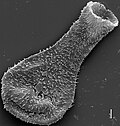Chitinozoan
Chitinozoans are an extinct group of marine organisms that thrived from the Ordovician to the Devonian period. They are recognized by their flask-shaped, organic-walled vesicles, which are believed to be egg cases or housing structures of an unknown type of marine animal. The study of chitinozoans is significant in the field of paleontology and biostratigraphy, as their remains are used to date and correlate rock strata.
Morphology
Chitinozoans are characterized by their varied shapes and sizes, typically ranging from 50 to 500 micrometers in length. Their most distinctive feature is their vase-like structure, with a closed top and an opening at the base. The wall of the vesicle is composed of organic material, and its surface can be smooth, ornamented, or segmented. Despite extensive study, the biological nature of chitinozoans remains a mystery, and they are often described based on their morphological characteristics.
Ecology
Chitinozoans are believed to have been planktonic, living freely in the marine environment. Their widespread distribution in various marine settings, from shallow to deep waters, suggests they were adaptable to different ecological niches. The presence of chitinozoans in large quantities in certain rock layers indicates they may have played a significant role in the marine ecosystems of their time.
Taxonomy and Classification
The classification of chitinozoans is primarily based on their morphological features. They are divided into several orders and families, with numerous genera and species described. However, their exact position in the tree of life is still debated among scientists. Some researchers propose that chitinozoans are related to protozoa, while others suggest a closer relationship with metazoa, particularly within the group lophophorates.
Geological Significance
Chitinozoans are important biostratigraphic markers. Their stratigraphic distribution is well-documented, making them valuable tools for dating and correlating sedimentary rock layers. They are especially useful in the study of Ordovician to Devonian strata, where they help in the reconstruction of paleoenvironments and in understanding the geological history of the Earth.
Research and Study
The study of chitinozoans involves the examination of rock samples under a microscope to identify and classify the vesicles. This research provides insights into the paleobiology and ecology of these enigmatic organisms. Additionally, chitinozoan studies contribute to our understanding of past marine environments and the evolutionary history of life on Earth.
Conclusion
Chitinozoans, with their distinctive morphology and widespread occurrence in ancient marine sediments, continue to intrigue scientists. Their role as biostratigraphic markers makes them invaluable in the field of geology and paleontology. Despite their extinction, the study of chitinozoans enhances our understanding of the Earth's past ecosystems and the evolutionary history of marine life.
This article is a paleontology stub. You can help WikiMD by expanding it!
Transform your life with W8MD's budget GLP-1 injections from $125.
W8MD offers a medical weight loss program to lose weight in Philadelphia. Our physician-supervised medical weight loss provides:
- Most insurances accepted or discounted self-pay rates. We will obtain insurance prior authorizations if needed.
- Generic GLP1 weight loss injections from $125 for the starting dose.
- Also offer prescription weight loss medications including Phentermine, Qsymia, Diethylpropion, Contrave etc.
NYC weight loss doctor appointments
Start your NYC weight loss journey today at our NYC medical weight loss and Philadelphia medical weight loss clinics.
- Call 718-946-5500 to lose weight in NYC or for medical weight loss in Philadelphia 215-676-2334.
- Tags:NYC medical weight loss, Philadelphia lose weight Zepbound NYC, Budget GLP1 weight loss injections, Wegovy Philadelphia, Wegovy NYC, Philadelphia medical weight loss, Brookly weight loss and Wegovy NYC
|
WikiMD's Wellness Encyclopedia |
| Let Food Be Thy Medicine Medicine Thy Food - Hippocrates |
Medical Disclaimer: WikiMD is not a substitute for professional medical advice. The information on WikiMD is provided as an information resource only, may be incorrect, outdated or misleading, and is not to be used or relied on for any diagnostic or treatment purposes. Please consult your health care provider before making any healthcare decisions or for guidance about a specific medical condition. WikiMD expressly disclaims responsibility, and shall have no liability, for any damages, loss, injury, or liability whatsoever suffered as a result of your reliance on the information contained in this site. By visiting this site you agree to the foregoing terms and conditions, which may from time to time be changed or supplemented by WikiMD. If you do not agree to the foregoing terms and conditions, you should not enter or use this site. See full disclaimer.
Credits:Most images are courtesy of Wikimedia commons, and templates, categories Wikipedia, licensed under CC BY SA or similar.
Contributors: Prab R. Tumpati, MD





